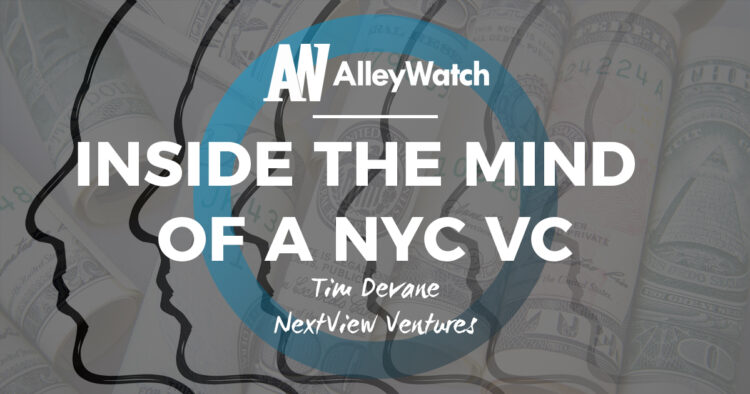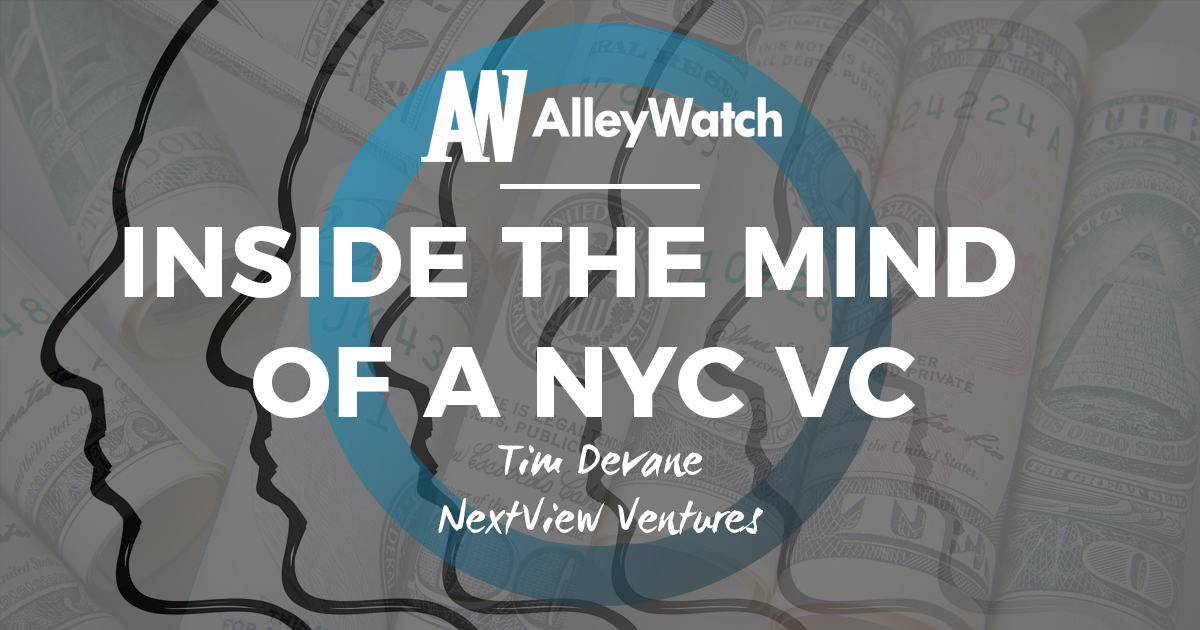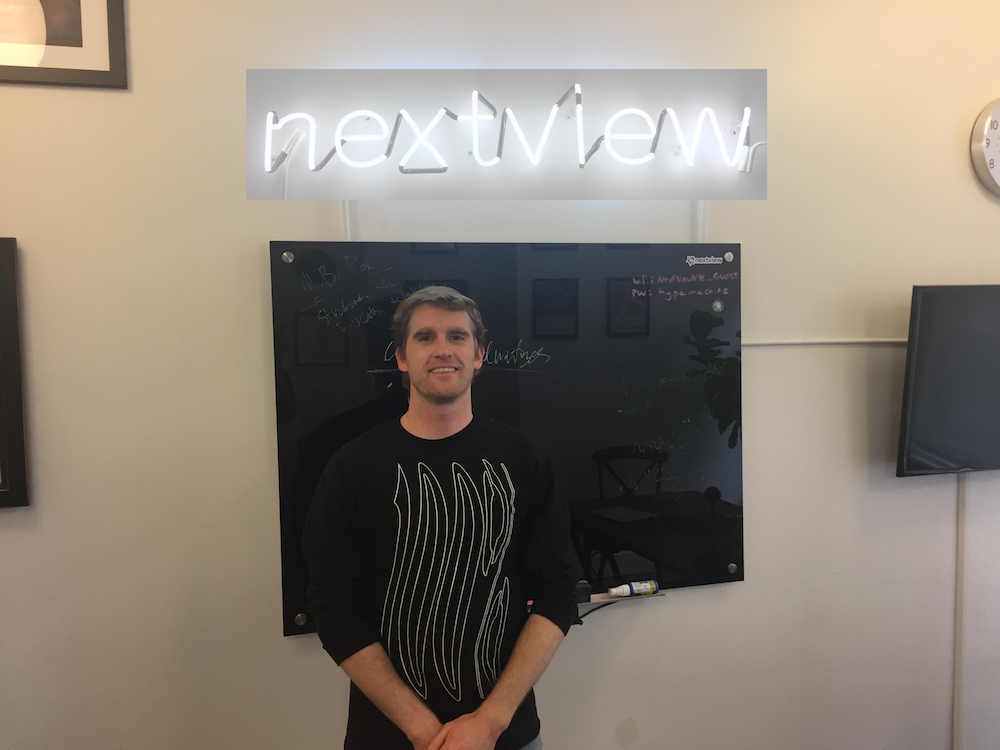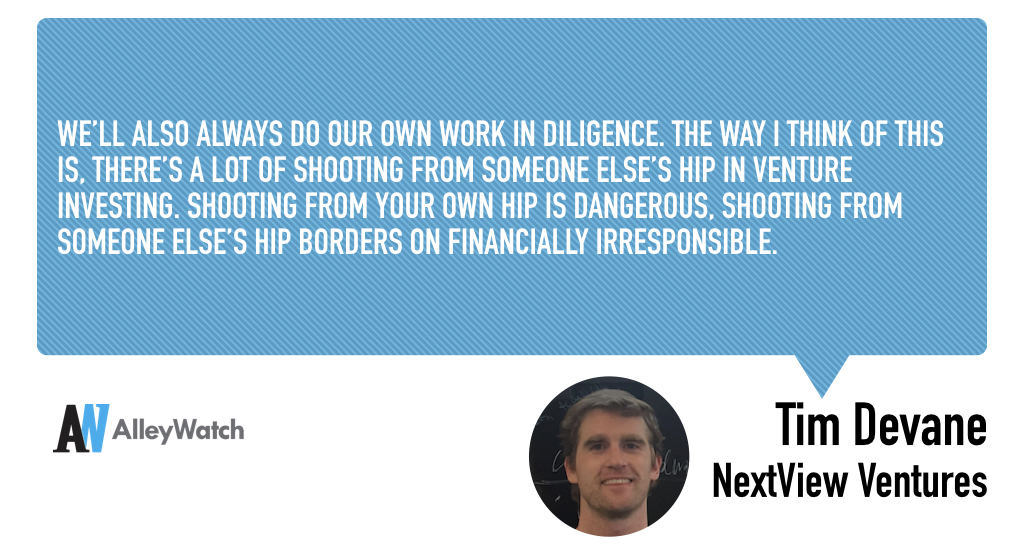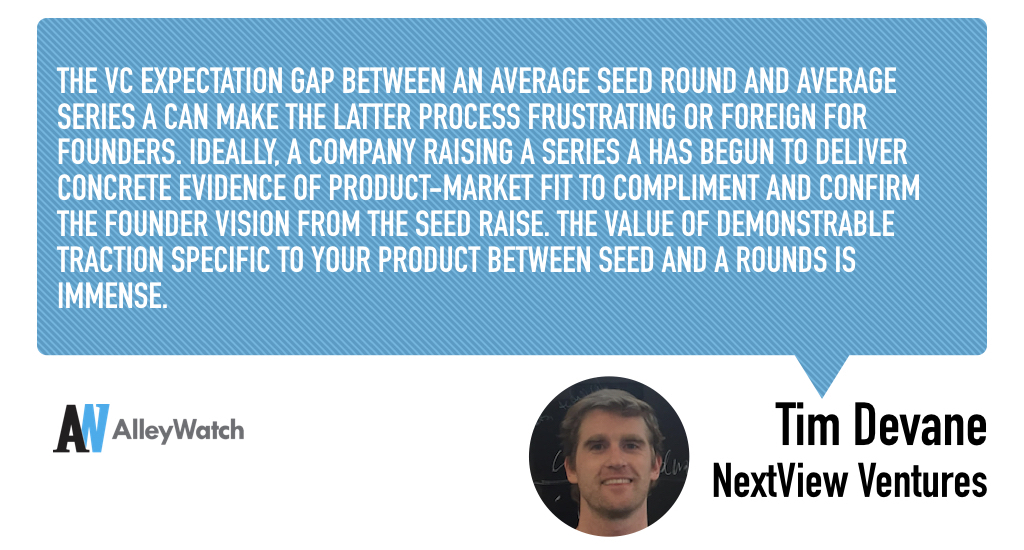Welcome back to Inside the Mind of an NYC VC, a new series at AlleyWatch in which we speak with New York City-based Venture Capitalists. In the hot seat this time is Tim Devane, Principal at NextView Ventures, a seed-focused early stage venture firm that today just announced its $50M third fund focused on “the Everyday Economy”. Tim stopped by to talk about his early career days at Betaworks and Bitly, his transition into venture, the NextView philosophy, and much, much more.
If you are a NYC-based VC interested in participating in this series, please send us an email. We’d love to chat. If you are interested in sponsoring this series that showcases the leading minds in venture in NYC, we’d also love to chat. Send us a note.
Tim Devane, NextView Ventures
Bart Clareman, AlleyWatch: Tell us about your journey into the venture business and how you came to be a Principal at NextView Ventures?
Tim Devane, NextView Ventures: I came out of undergrad at a really crappy time to graduate – it was 2009 so I was graduating into the fall of the housing crisis. No one had jobs.
I had this vague but nagging interest in early stage venture. At that time I couldn’t have told you why, but over the course of the better part of a decade it’s become crystallized in my mind why I’m drawn to it.
Often venture is described as this mile-wide, inch-deep pursuit – variety over immersion in one subject . For a lot of people that’s not appealing, but for me its been the backbone of my career so far. When I reflect on it now, I think that’s what drew me as an undergrad to a liberal arts university like Wesleyan, which encourages diversity in fields of study and structured to help students succeed in a breadth of pursuits. The ethos as I conceived it was, “you don’t have to just be this.” Part of me was just drawn to that for college, and I think venture and the portfolio model in investing is one of the closest things to that in the working world.
But back to how I ended up here in the first place: I grew up in Washington, D.C. but I had no interest in I staying in Washington after college, so in October 2009 I sold my car in order to move up to NYC and basically couch surf. It was a study in making as small a foot print as possible while pounding the pavement during the day in job search. Besides asking people to meet me it was all pasta, coffee, 11b Express pizza in alphabet city, and wifi at Café Pick Me Up.
I was getting toward the end of my rope as far as ability to support myself when I was introduced to [Betaworks Co-Founders] Andy Weisman and John Borthwick, both of whom are Wesleyan graduates.
So I went into Betaworks for the first time armed with nothing so I did the only thing I could think of to make an impression: I wore the nicest (and only) suit I had. My sister had just gotten married so I had the suit I wore to her wedding and I had a real loud, big tie, and I walk into Betaworks, and everyone was in tshirts.
My heart sank. I said to myself, “whatever this job is, I’m not getting it.” But Andy and John as well as Josh Auerbach and Andrew Cohen thought it was funny or they thought that I was taking it so seriously in order to compensate for the void of being young. They hired me.
At the time, Betaworks was creating and helping to shape real-time social communication and content. They’d started several companies in the Twitter ecosystem and invested in Tumblr, Foursquare, and Twitter. But it was still early days so they effectively said, we think we’re headed in an interesting direction, there’s lots we need help with, if you can figure out what that job is you can keep it.
It was very much a carve out a space for yourself type of thing, and it was really extraordinary. I absorbed so much from Andy and the betaworks’ lens on investing.
On the studio side, engineering and design-focused teams were going from whiteboard to launch, and I got to experience this over and over again as Betaworks created more and newer products. It was: “we think we can build this, we’re building it, we’re launching it”. Its hard for me to express how exciting this time was and how valuable it has been to my venture career so far.
After about a year, I joined Bitly, the first Betaworks studio company to raise outside financing. What that meant was turning my chair around basically, because we all worked in the same office. I worked there 3.5 years as the first non-technical hire apart from the General Manager. At first it was all hands on deck, do whatever’s necessary, and then it was scoping out what are the values here beyond just link shortening? Is there an enterprise product? It was revenue discovery, building a paid offering and starting to bring it to market. This evolved as it started working into building out the bitly business organization.
Not just anyone could have succeeded. What enabled you to get into that position and then actually succeed?
I think it was a moment in time opportunity as much as anything else. I don’t think that those types of ‘open-interpretation’ roles exist beyond the earliest days of an organization’s life. So, there was luck and serendipity to that for me.
I was very eager. At the very least, I was loyal and passionate about helping shape identities for these companies and about growing them.
It was very much a take it and run as far/fast as you can type of attitude towards new ideas and products. I found that thrilling and endlessly intriguing.
Back to Bitly. You did that for 3.5 years, and was it right into Red Sea after that?
Yes, I met Scott [Birnbaum, Founder of Red Sea Ventures] through another chance catch up with another VC in New York. Again, serendipity plays so much into it. And RSV became an opportunity to put both feet in the water in seed investing in New York City. I was at Red Sea for two years. In that time, I worked closely with portfolio companies including Electric Objects, Point, Campus Job which became WayUp, and Outdoor Voices.
At the same time I did another startup as a COO, which was called Epic Magazine, based in California. It was more closely aligned with my undergrad major, which was creative writing. Epic created long-form, non-fiction stories, published with beautiful, dynamic visual design online for free. The core business model revolved around first-look and adaptation partnerships with other mediums – film, TV, podcasts, books, and brand-sponsored content. Co-founders Josh Davis and Josh Bearman are preeminent raconteurs and were so good to me. They taught me about entirely different industries and ways of looking at things. They also welcomed me in to help explore, structure, and grow the Epic business. The whole experience – challenges, vision, sector – was so different from that of the early days of Bitly.
Beyond helping with structure, process and business development, I took the lead on our seed fundraising process on the entrepreneur side. We ended up raising from a strong syndicate of NY and SF seed funds and angels with a major television network making a strategic investment in the round as well.
The other thing that I did was a couple of Betaworks one-off projects. I was a PM for The Players’ Tribune in the prelaunch run-up phase. And for me I thought it was great because it was product experience. I had a lot of impact on that before it launched and through to launch and then cycled off once it was up and running.
In Spring ’15, I connected with Rob Go (co-founder NextView Ventures) and in spending time with him, as well as his partners and cofounders Dave Beisel, Lee Hower and NextView’s VP of Platform at the time Jay Acunzo, I was totally hooked on the NextView ethos: the way that we hold ourselves accountable, how we expect ourselves to operate as well as what we look for in entrepreneurs. This was fund that clearly stood for backing people who were extraordinarily talented and smart and who worked hard, and they embodied all of those qualities themselves.
I joined the firm in Summer 2015 to help build NextView New York.
When you joined NextView in 2015 you became the first full time team member in New York. Why was that a priority for NextView, and what were the challenges for you in establishing the firm’s presence here?
Well, a third of Nextview’s investments that pre-dated me were in New York-based companies. The fund was founded in Boston where all of my colleagues are based. But Boston and New York were both important to the NextView thesis, so everyone had been living on the N.E. Amtrak between the two cities already.
New York City was and still is a growing ecosystem but growing quickly, and we wanted to establish a permanent presence here. A number of the most successful companies in the NextView portfolio were New York-based companies, so it was really about amplifying the firm even more in NYC.
We experiment around initiatives and content and events and brand and let people know who you are and what you stand for.
Say more about the NextView philosophy. The NextView website describes you guys as “high conviction, hands-on Seed investors” – take those two in turn. What is meant by “high conviction” and what does “hands-on” look like for NextView?
High conviction is akin to when we say, “we will make our decision in a vaccum.” We believe in the decision-making process we have no matter the structure of your round or the syndicate involved.
We’ll also always do our own work in diligence. The way I think of this is, there’s a lot of shooting from someone else’s hip in venture investing. Shooting from your own hip is dangerous, shooting from someone else’s hip borders on financially irresponsible.
It’s just as common that we are the only institutional investor participating in an early round with a bunch of individuals as we are one of three funds that are around the table. We don’t require the latter to invest in your company, which I think is meaningful to entrepreneurs who so often hear the “once you have a lead…” feedback.
“Hand’s on” describes perspective and intention in working with companies post investment. We have both established initiatives and more generally consider ourselves five ‘utility employees’ for the portfolio. The specific work ranges from the most strategic, as we tend to join boards, to the most literal, like finding a cheaper office space or deciding which accounting software to use. I think we all enjoy helping companies however we can.
Say more about what you guys do for your portfolio companies and the importance of a platform play more broadly?
Nextview’s approach to working with the portfolio centers on four pragmatic operational areas: building a great team, building a great product, getting more customers, and not running out of money. In addition to the five of us, we have entrepreneur advisors with backgrounds in each area. We have an email-based Talent Exchange that’s distributed to portfolio founders based on geography.
Platform at NextView has focused on creating an evergreen content library as a resource valuable for the portfolio as well as the external startup communities we are a part of and represent. We all contribute blogposts regularly; we have a podcast called Traction; we’ve created a number of guides, templates, and How-To’s aimed at helping young companies and seed-stage founders.
There seems to be a lot of momentum around platform initiatives in VC. Is it fair to say that having a platform is “table stakes” at this point? If so, how do you stand out?
Everyone at NextView shares an interest in content creation driving many platform initiatives. With a thematic focus on traction for early-stage startups. We since expanded further with programmatic hiring initiatives for the portfolio and a variety of event series in New York and Boston. Ginny Mineo is Director of Platform at NextView and she’ll continue to evolve how we think about and prioritize different initiatives.
You block out time each month to read the investment memos for NextView’s existing portfolio – what have you learned from that process, and how does it inform what you look for in an investment opportunity?
I think of our investment memo as the only time-stamped record of our thought process regarding the portfolio that’s not biased by hindsight. That makes the two page memos meaningful artifacts detailing how we invest – themes, process, focus. As a tome, the memos chronicle the evolution of how we invest.
So, I’d say they offer additional, valuable data points, for our current and future evaluation and diligence.
What does the quintessential NextView portfolio company look like?
Companies that can impact and improve daily life for the largest groups of people.
You hear a lot about the Series A crunch. NextView always invests first at the Seed stage; what’s your perspective on the Series A crunch? Is it a real phenomenon, is it overblown, and is it affecting your portfolio companies?
Something that I’ve noticed that Series A crunch talk is any mention of a less than linear pre-Series A fundraise. I mean seed extension, follow-on debt raises, insider-led flat rounds. These are normal! Varied, early financing trajectories don’t necessarily imply Armageddon or Series A crunch. So on one hand, I think the crunch is exaggerated due to unrealistic expectation of perfectly templated funding growth.
The VC expectation gap between an average seed round and average Series A can make the latter process frustrating or foreign for founders. Ideally, a company raising a Series A has begun to deliver concrete evidence of product-market fit to compliment and confirm the founder vision from the seed raise. The value of demonstrable traction specific to your product between seed and A rounds is immense.
To the extent that’s a phenomenon you’ve seen several times, how do you view your role as the Seed round investor to prepare your entrepreneurs and portfolio companies for what is going to be required at the A round level.
One of the most important things psychologically is, not just messaging it publicly, but also just getting a figure in your mind that you “need” to raise when it’s not the right number.
Just like anything, once it’s there it’s very difficult for them to say “we didn’t hit the ideal number, we failed.” It’s vitally important to have the prep that isn’t, let’s talk about Slide 5, but rather, let’s have a discussion of what you actually need and not rule anything out so that we can sort out what’s best for the progress of your company.
What trends are you watching closely at the moment?
Over the course of this year my colleague David and I have spent time on a deep dive around voice technology. That led to a deeper push into true machine learning and artificial intelligence focused on true applications of large, proprietary, previously untapped data sets supervising machine ability working a bit into unsupervised neural networks.
OK, liberal arts grad to liberal arts grad, humanities major to humanities major: if you knew in college that you’d end up working in tech, would you still have been an English – Creative Writing major? Or would there have been a better use of your time?
I’ve thought about this a lot. I would say, I look back on it and I can say with certainty I would have gone to Wesleyan. I really enjoyed it.
Now, would I have done comp sci or try to put something in there that’s a harder skill that’s, maybe not quite vocational, but at least starts to educate me more toward a career in tech in New York? Probably. But I can also say confidently that I would not have gone and tried to get the comp sci major, even if I knew this was a path I was going to pursue.
For one thing, the choices I made have served me alright thus far, so that is an input. Two, the enjoyment I took in my major combined with what I believe is a true skill, writing, is something I greatly value. Three, the benefit of liberal arts translates most directly to the portfolio model. Without that breadth, I’d be worried that it would get boring. Every day is so different. It’s very stimulating intellectually, and I’m very grateful for that.
And as an authority on writing, give us your greatest hits – what books should everyone read?
My favorite non-fiction book is Darkness Visible by William Styron and fiction I’ll say Midnight’s Children by Salman Rushdie and The Savage Detectives by Roberto Bolaño.
What are the most over- or under-hyped parts of the tech ecosystem?
I think the hype cycle gets most out of control when newer technologies are slapped on a startup’s pitch or product vision when the two don’t make sense together. That’s often obvious and I’d say its less productive and less authentic to grasp at trends for the sake of hype than it is to pitch your own vision, regardless of where it falls in the hype scale.
And under-hyped? I guess I have to keep those on the dl so not to feed the hype machine!
Who is a venture investor you admire and why?
Esther Dyson, I’ve always admired her from afar, I’ve never met her. She seems to really pour herself – as an investor, entrepreneur, writer, activist – into her evolving passions and to really, purely enjoy and get excited about what she’s spending her time doing. I hope I can meet her someday!


